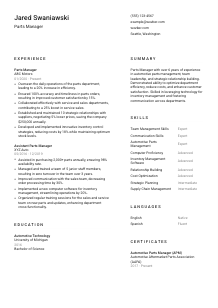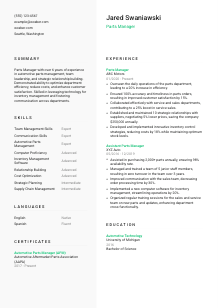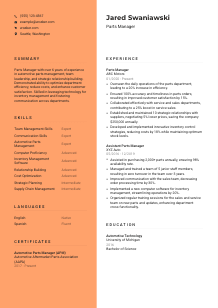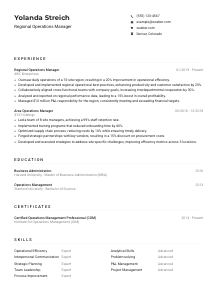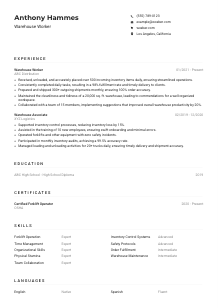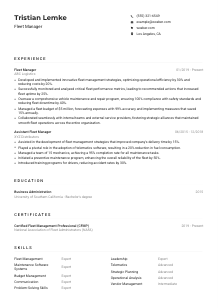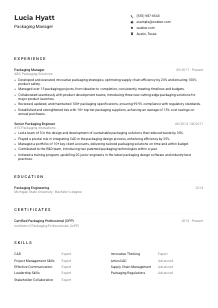Parts Manager Resume Example
Mastering inventories, but your resume falls out of stock? Unpack this Parts Manager resume example, assembled with Wozber free resume builder. Grasp how to integrate your procurement prowess with the demands of the role, positioning your career for perpetual growth without any backorders!
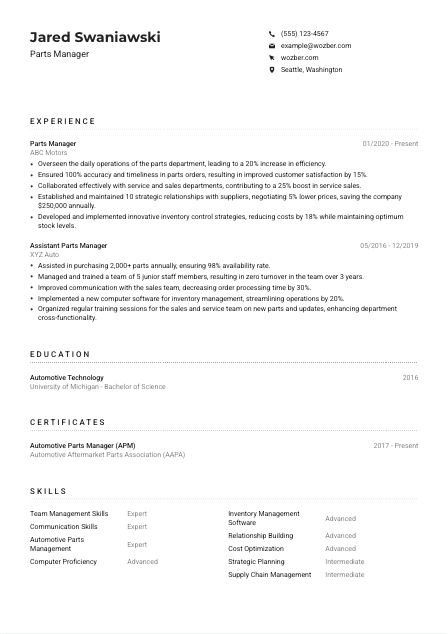
How to write a Parts Manager Resume?
Hello, future Parts Manager superstar! Landing a dream job in the automotive industry starts with creating a resume that stands out. We know the Parts Manager role is unique, combining expertise in automotive parts, leadership, and operational efficiency. That's why we've tailored this guide specifically for you, using the Wozber free resume builder.
This tool is your key to an ATS-compliant resume that shines as much as a polished chrome bumper. Get ready to rev your career engine, and let's jumpstart this journey together!
Personal Details
First impressions matter, especially when it comes to your resume. The Personal Details section is your chance to put your best foot forward. It's not just about contact information; it's about signaling to the employer that you're a local candidate, ready and able to take the Parts Manager role head-on. Here's how to fine-tune this section to the job's specifics and start off on the right gear.
1. Stand Out with Your Name
Think of your name as your personal brand's logo. It should be bold and catch the eye. Use a clear font and a size that makes it pop. You want the hiring manager to remember your name, associating it with reliability and efficiency, qualities essential for a Parts Manager.
2. Pinpoint Your Job Title
Just beneath your name, proudly state your aspiration: 'Parts Manager.' This clear indicator of your career focus tells the hiring manager that your skills and ambitions align perfectly with what they're looking for, creating an instant connection.
3. Get in Touch
Ensure your phone number and professional email address (preferably yourname@provider.com) are correct and easy to find. A mistake here could mean a missed opportunity. Remember, in the world of auto parts, precision is key—and that starts with your contact info.
4. Drive Home Your Location
"Seattle, Washington" isn't just an address; it's a strategic piece of information that ticks one of the boxes in the job requirements. This detail reassures the employer there are no relocation delays to worry about—you're ready to roll when they are.
5. A Professional Profile Worth a Double-take
Adding a LinkedIn profile or a personal website can showcase your professional image beyond the resume. Ensure it's current and reflects the same information. It's like the glossy finish on a well-maintained car, showing you care about your professional appearance.
Takeaway
Every element of the Personal Details section is an opportunity to signal your professionalism and alignment with the Parts Manager role. Consider it the prelude to your resume—set the stage with precision, clarity, and a bit of strategic polish. You're not just listing details; you're beginning the narrative of why you're the perfect fit.





Experience
The Experience section is where your resume shifts into high gear. You'll demonstrate your expertise in managing automotive parts, leading teams, and enhancing operational efficiency. Let's map out how to structure this section to reflect your achievement in the automotive industry.
- Overseen the daily operations of the parts department, leading to a 20% increase in efficiency.
- Ensured 100% accuracy and timeliness in parts orders, resulting in improved customer satisfaction by 15%.
- Collaborated effectively with service and sales departments, contributing to a 25% boost in service sales.
- Established and maintained 10 strategic relationships with suppliers, negotiating 5% lower prices, saving the company $250,000 annually.
- Developed and implemented innovative inventory control strategies, reducing costs by 18% while maintaining optimum stock levels.
- Assisted in purchasing 2,000+ parts annually, ensuring 98% availability rate.
- Managed and trained a team of 5 junior staff members, resulting in zero turnover in the team over 3 years.
- Improved communication with the sales team, decreasing order processing time by 30%.
- Implemented a new computer software for inventory management, streamlining operations by 20%.
- Organized regular training sessions for the sales and service team on new parts and updates, enhancing department cross‑functionality.
1. Analyze the Job Description
Before diving into your professional history, take a close look at the job description. It's like inspecting a car part; you need to understand every aspect. For a Parts Manager role, focus on experiences related to parts management, leadership, and inventory optimization.
2. Detail Your Professional Journey
Begin with your most recent role and work backward. For each position, include your title, company name, and the period of employment. This chronological layout helps the hiring manager to quickly grasp the progression of your career and your growing responsibilities.
3. Highlight Your Achievements
Under each role, pinpoint accomplishments that align with the job description. Did you improve efficiency by 20%? Negotiate with suppliers to save costs? These are your headline acts, proving you not only understand the Parts Manager role but excel in it.
4. Add Numbers for Clarity
Quantifying your achievements makes your resume more compelling. Whether it's the percentage by which you improved order accuracy or the amount saved through supplier negotiations, numbers provide tangible proof of your impact and prowess as a Parts Manager.
5. Focus on Relevance
Stick to experiences that align with the Parts Manager role, trimming any unrelated details. Keeping your resume streamlined and focused demonstrates that you understand the importance of efficiency and precision—key qualities for managing automotive parts.
Takeaway
Your experience is the engine of your resume, driving home your capability and suitability for the Parts Manager role. Tailor this section to reflect not just where you've been, but how those experiences have prepared you for this next stage in your career. Paint a picture of a proactive, efficient Parts Manager, ready to take the wheel.
Education
In the automotive industry, a solid educational background can give you a competitive edge. The Education section of your resume is more than a list of schools; it's a testament to your dedication to learning and growing. Let's look at how to set this section up for the Parts Manager position.
1. Identify Necessary Education
First, review the job posting to catch any specified educational requirements. For our example, a Bachelor's in Automotive Technology aligns well with the expectations for a Parts Manager, providing a strong foundation in the field.
2. Keep It Clean and Organized
Present your educational background in a clear, straightforward manner. List your degree, field of study, institution, and graduation year. This tidy format allows hiring managers to quickly verify your qualifications without getting lost in the details.
3. Tailor Your Degree Details
If your degree directly relates to the Parts Manager role, such as a Bachelor's in Automotive Technology, make sure it's front and center. Highlighting relevant coursework or projects can further showcase your preparedness for this specific position.
4. Point Out Pertinent Courses
For positions like Parts Manager, where specialized knowledge is crucial, identifying relevant courses you've taken reinforces your expertise. Whether it's inventory management, logistics, or leadership training, these details underline your readiness for the role.
5. Additional Educational Achievements
Should you have honors, extracurriculars, or other educational accolades that highlight leadership or automotive passion, include them. These can be particularly effective for budding Parts Managers, underscoring your commitment to excellence.
Takeaway
The Education section solidifies your foundation, providing a snapshot of your preparedness for the Parts Manager role. It's not just about where you went to school but showcasing a lifelong commitment to learning and leadership. Craft this section to drive home your expertise and dedication.
Certificates
For a Parts Manager, certifications can be the equivalent of performance parts in a car—they enhance your resume, demonstrating specialized knowledge and commitment to your profession. Let's navigate how to display your certifications effectively.
1. Connect with Job Requirements
Start by reviewing the job posting for specific certifications. Our example mentions that a certificate in Automotive Parts Manager is a plus. If you have it, or any relevant certification, it's time to let it shine.
2. Prioritize Relevant Certifications
It's tempting to list every certification you've ever earned, but focus on those most relevant to a Parts Manager role. Whether it's APM or another industry-recognized credential, these are your highlights, showing commitment to your career specialization.
3. Keep Dates in Check
For certifications, especially in technology or processes that evolve, include acquisition or expiration dates. This transparency shows potential employers that your knowledge is current and you're dedicated to staying on top of industry trends.
4. Stay Ahead of the Curve
The automotive industry is always advancing, and so should you. Regularly updating your certifications and seeking out new learning opportunities not only bolsters your resume but demonstrates a proactive approach to your career development.
Takeaway
Certificates are proof of your ongoing commitment to excellence in the Parts Manager realm. They are key enhancements to your professional profile, showcasing your dedication to maintaining high standards in your craft. Highlight them with pride and keep pushing your boundaries.
Skills
The Skills section of your resume is where you get to showcase the specific capabilities that make you the ideal candidate for a Parts Manager. Here, specificity is your friend—the goal is to align your skills as closely as possible with the job description. Let's rev up and explore how to effectively list your skills.
1. Dissect the Job Description
Begin with a thorough examination of the job listing. Look for both hard and soft skills that are highlighted as important. For a Parts Manager, this could include "deep knowledge of automotive parts", "team management", and "inventory software proficiency".
2. Match and List Your Skills
After identifying the key skills from the job description, reflect on your own skill set. Align your skills with those requested, using the same language the employer uses. This ensures your resume speaks directly to the job's requirements and sails through ATS screenings.
3. Organize for Impact
While you might possess a broad spectrum of skills, prioritize those most relevant to a Parts Manager role. This not only makes your resume more readable but also reinforces your suitability for the position, making it clear you're not just a candidate—you're the candidate.
Takeaway
Your Skills section is a showcase of the tools in your professional toolbox. Carefully selected and aligned with the job requirements, they demonstrate unequivocally that you're equipped to excel as a Parts Manager. View this section as an opportunity to impress and reassure the hiring manager of your readiness for the role.
Languages
In an increasingly globalized world, the ability to communicate in multiple languages can set you apart as a Parts Manager. Whether it's liaising with international suppliers or catering to a diverse customer base, language skills can be a significant asset. Let's decode how to present your linguistic abilities.
1. Start with the Must-haves
The job description specifies "English speaking proficiency required." Make sure English is listed first, with an accurate assessment of your proficiency level. This directly addresses a key requirement, positioning you as a fit for the role.
2. Showcase Additional Languages
If you possess proficiency in languages beyond English, list them as well. Each additional language is a door to new opportunities and signifies your capability to navigate a multicultural environment—a plus for any Parts Manager.
3. Be Honest About Your Level
Accuracy in self-assessment is crucial. Use clear, universal terms like "Native", "Fluent", "Intermediate", and "Basic" to describe your proficiency. This honesty reflects integrity and aids in setting realistic expectations for your role as a communicator.
4. Understand the Job's Scope
Consider the role's requirements and the company's reach. If the Parts Manager position involves international dealings, emphasizing your multilingual abilities could be particularly advantageous, showcasing your readiness to operate on a global stage.
5. Languages as a Reflection of Adaptability
Beyond mere communication, your language skills imply adaptability and a willingness to engage with diverse cultures. This can be especially relevant in negotiatin scenarios, reflecting a broad-minded approach to leadership and problem-solving.
Takeaway
Your ability to speak multiple languages is more than a skill—it's a testament to your adaptability and global perspective. In a Parts Manager role, this can translate into enhanced relationships with suppliers and customers alike. Show off your linguistic prowess and embrace your role as a global communicator.
Summary
Crafting a compelling Summary section is like fine-tuning a high-performance engine—it makes your entire resume run smoother and more powerfully. This is your chance to encapsulate your professional identity and what makes you an ideal candidate for the Parts Manager position in just a few lines.
1. Capture the Job's Essence
Begin with a bird's eye view of what the Parts Manager role entails, focusing on key attributes like leadership, knowledge of automotive parts, and efficiency optimization. Your summary should echo these requirements, positioning you as the perfect candidate.
2. Lead with a Strong Opening
Start your summary with a powerful statement about your professional stature in the automotive parts sector. Highlighting your years of experience and key achievements sets the tone, establishing you as a seasoned and effective Parts Manager right off the bat.
3. Tackle Key Skills and Achievements
Choose two to three core strengths or accomplishments that mirror the job's demands. For instance, emphasizing your role in elevating department efficiency and your knack for fostering cross-departmental communication reflects directly on the job description's requirements.
4. Keep It Sharp
Your summary should be concise, yet impactful. Aim for three to five lines that not only introduce you but also entice the hiring manager to keep reading. Think of it as your personal ad—what makes you stand out as the Parts Manager they've been searching for?
Takeaway
The Summary section is your spotlight moment. It's your opportunity to grab the hiring manager's attention and make a memorable impression. Craft it with care, ensuring it reflects not just your experience and skills, but also your passion for the Parts Manager role. Let your summary pave the way for your resume's success.
Launching Your Parts Manager Journey
There you have it—a detailed roadmap to crafting a resume that not only meets the mark but surpasses it. By following these tailored steps and utilizing the Wozber free resume builder, you're not just creating an ATS-compliant resume; you're crafting a powerful tool that showcases your unique suitability for the Parts Manager role. Remember, your resume is more than a document—it's the key to your next career opportunity. Take these insights, apply them with care, and drive your career forward.
Your dream Parts Manager position awaits. Let's get to work!

- Minimum of 5 years experience in parts management or automotive industry.
- Proven leadership and team management skills.
- Deep knowledge of automotive parts and systems.
- Strong computer and inventory management software proficiency.
- Excellent interpersonal and communication skills.
- Certification in Automotive Parts Manager or related field is a plus.
- English speaking proficiency required.
- Must be located in Seattle, Washington.
- Oversee the daily operations of the parts department, including purchasing, inventory control, and staffing.
- Ensure the accuracy and timeliness of parts orders, deliveries, and returns.
- Collaborate with service and sales departments to provide necessary parts for repairs and new vehicle sales.
- Establish and maintain relationships with suppliers, negotiating prices and terms for parts and services.
- Develop and implement strategies to optimize department efficiency, reduce costs, and enhance customer satisfaction.





